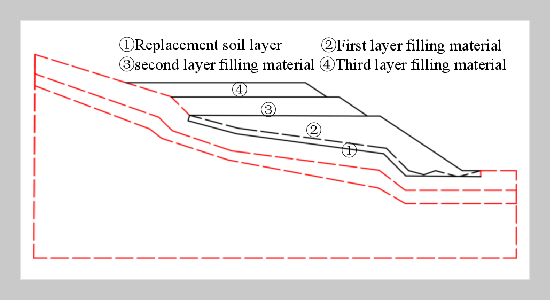- [1] R. Burgueo and B. S. Pavlich, (2011) “Evaluation of prefabricated composite steel box girder systems for rapid bridge construction" Dissertations & Theses Grad�works:
- [2] D. Agrawal, U. Waghe, K. Ansari, M. Amran, Y. Gamil, A. E. Alluqmani, and N. Thakare, (2024) “Op�timization of eco-friendly concrete with recycled coarse aggregates and rubber particles as sustainable industrial byproducts for construction practices" Heliyon 10(4): DOI: https://doi.org/10.1016/j.heliyon.2024.e25923.
- [3] F. Agliardi, G. Crosta, and A. Zanchi, (2001) “Struc�tural constraints on deep-seated slope deformation kine�matics" Engineering Geology: 83–102. DOI: https://doi.org/10.1016/S0013-7952(00)00066-1.
- [4] D. Stead, E. Eberhardt, and J. Coggan, (2006) “De�velopments in the characterization of complex rock slope deformation and failure using numerical modelling tech�niques." Engineering Geology: 217–235. DOI: https://doi.org/10.1016/j.enggeo.2005.06.033.
- [5] E. B. Masi, S. Segoni, and V. Tofani, (2021) “Root Rein�forcement in Slope Stability Models: A Review" Geo�sciences: 212. DOI: https://doi.org/10.3390/geosciences11050212.
- [6] Z. Song, Y. Cheng, X. Tian, J. Wang, and T. Yang, (2020) “Mechanical properties of limestone from Maixi tunnel under hydro-mechanical coupling" Arabian Jour�nal of Geosciences: 1–13. DOI: https://doi.org/10.1007/s12517-020-05373-z.
- [7] Z. Song, T. Wang, J. Wang, K. Xiao, and T. Yang, (2022) “Uniaxial compression mechanical properties and damage constitutive model of limestone under osmotic pressure" International Journal of Damage Mechan�ics: 557–581. DOI: https://doi.org/10.1177/10567895211045430.
- [8] X. Yang, Y. Zhu, Y. Zhou, X. Yang, Z. Shi, et al. Time�space monitoring and stability analysis of high fill slope slip process at a airport in mountain region. 2016. DOI: https://doi.org/10.13722/j.cnki.jrme.2016.0097.
- [9] Z. Zhang, Q. Sheng, D. Song, X. Fu, Y. Zhou, and J. Huang, (2023) “Stability evaluation of the high fill deposit slope subjected to rainfall considering water dete�rioration" Bulletin of Engineering Geology and the Environment: 1–19. DOI: https://doi.org/10.1007/s10064-023-03083-w.
- [10] S. Wang, (1981) “On the mechanism and process of slope deformation in an open pit mine" Rock Mechanics Felsmechanik Mécanique des Roches: 145–156. DOI: https://doi.org/10.1007/BF01239035.
- [11] A. Rotaru, F. Bejan, and D. Almohamad, (2022) “Sus�tainable Slope Stability Analysis: A Critical Study on Methods" Sustainability: 8847. DOI: https://doi.org/10.3390/su14148847.
- [12] G. Zhang, Y. Wang, and F. Luo, (2022) “Simplified method for analyzing soil slope deformation under cyclic loading" Journal of Rock Mechanics and Geotechni�cal Engineering: 1967–1976. DOI: https://doi.org/10.1016/j.jrmge.2022.01.005.
- [13] H. Anping and Y. Shuaihua, (2020) “Sensitivity of High Fill Slope Stability Factors under Seismic Conditions" Soil Mechanics and Foundation Engineering: 356– 363. DOI: https://doi.org/10.1007/s11204-020-09678-9.
- [14] B. Yuan, Z. Li, Z. Su, Q. Luo, M. Chen, and Z. Zhao, (2021) “Sensitivity of Multistage Fill Slope Based on Fi�nite Element Model" Advances in Civil Engineering: 6622936(1–13). DOI: https://doi.org/10.1155/2021/6622936.
- [15] X. Tian, Z. Song, and Y. Zhang, (2021) “Monitoring and reinforcement of landslide induced by tunnel excavation: A case study from Xiamaixi tunnel" Tunnelling and Underground Space Technology: 103796. DOI: https://doi.org/10.1016/j.tust.2020.103796.
- [16] R. Hack, (2000) “Geophysics For Slope Stability" Sur�veys in Geophysics 21(4): 423–448. DOI: https://doi.org/10.1023/A:1006797126800.
- [17] B. Viswanadham and D. König, (2008) “Centrifuge modeling of geotextile-reinforced slopes subjected to differ�ential settlements" Geotextiles and Geomembranes: 77–88. DOI: https://doi.org/10.1016/j.geotexmem.2008.09.008.
- [18] M. Badanagki, S. Dashti, and P. Kirkwood, (2018) “Influence of Dense Granular Columns on the Performance of Level and Gently Sloping Liquefiable Sites" Journal of Geotechnical and Geoenvironmental Engineering: 04018065. DOI: https://doi.org/10.1061/(ASCE)GT.1943-5606.0001937.
- [19] L. Ma, K. Yang, W. Yuan, L. Li, Y. Wei, C. Ma, F. Luo, and G. Zhang, (2020) “Centrifuge modeling of the pile foundation reinforcement on slopes subjected to uneven settlement" Bulletin of Engineering Geology and the Environment: 2647–2658. DOI: https://doi.org/10.1007/s10064-020-01723-z.
- [20] B. M. Douglas, E. A. Maragakis, and B. Nath, (1990) “Static Deformations of Bridges From Quick-Release Dy�namic Experiments" Journal of Structural Engineer�ing: 2201–2213. DOI: https://doi.org/10.1061/(ASCE)0733-9445(1990)116:8(2201).
- [21] H. Gou, R. Xie, C. Liu, Y. Bao, and Q. Pu, (2021) “An�alytical study on high-speed railway track deformation under long-term bridge deformations and interlayer degra�dation" Structures: 1005–1015. DOI: https://doi.org/10.1016/j.istruc.2020.10.079.
- [22] M. Bayat, M. Bayat, et al., (2023) “Data-driven model�ing of optimal intensity measure of soil-nailed wall struc�tures" Structural Engineering and Mechanics: 85–92. DOI: https://doi.org/10.12989/sem.2023.86.1.085.
- [23] I. Pakar and M. Bayat, (2013) “An Analytical Study of Nonlinear Vibrations of Buckled Euler-Bernoulli Beams" Acta Physica Polonica A: 48–52. DOI: https://doi.org/10.12693/aphyspola.123.48.
- [24] M. Bayat, I. Pakar, and M. Bayat, (2013) “Analytical solution for nonlinear vibration of an eccentrically rein�forced cylindrical shell" Steel and Composite Struc�tures: 511–521. DOI: https://doi.org/10.12989/scs.2013.14.5.511.
- [25] K.-c. Sun, L.-f. Liu, H.-j. Ming, X.-f. Xu, Q. Li, and J.-x. Tong, (2016) “Experimental research on the Influence of Particle Size and Gradation on repose Angle of rockfill" Journal of Changjiang River Scientific Research Institute: 91–95. DOI: https://doi.org/10.11988/ckyyb.20150632.
- [26] Z. Shuo, P. Xiangjun, H. Runqiu, W. Qi, C. Yingjiang, and W. Zilong, (2017) “Loading deformation process and mechanical characterisitcs of high fill loess slope" Journal of Engineering Geology: 657–670. DOI: https://doi.org/10.13544/j.cnki.jeg.2017.03.011.
- [27] L. W. Abramson, (1995) “Slope Stability and Stabiliza�tion Methods" Slopes: DOI: https://doi.org/10.2113/gseegeosci.II.3.447.
- [28] J. M. Duncan, S. G. Wright, and T. L. Brandon, (2005) “Soil Strength and Slope Stability" slope failure:
- [29] J. T. Christian, C. C. Ladd, and G. B. Baecher, (1994) “Reliability Applied to Slope Stability Analysis" J. Geotech. Engrg: 2180–2207. DOI: https://doi.org/10.1061/(ASCE)0733-9410(1996)122:5(417).
- [30] D. V. Griffiths and G. A. Fenton, (2004) “Probabilistic Slope Stability Analysis by Finite Elements" Journal of Geotechnical and Geoenvironmental Engineering 130(5): 507–518. DOI: https://doi.org/10.1061/(ASCE)1090-0241(2004)130:5(507).
- [31] O. C. Zienkiewicz, C. Humpheson, and R. Lewis, (1975) “Associated and non-associated visco-plasticity and plasticity in soil mechanics" GEOTECHNIQUE: 671–689. DOI: https://doi.org/10.1680/geot.1975.25.4.671.
- [32] Y. Wang, Z. Cao, and S.-K. Au, (2010) “Efficient Monte Carlo Simulation of parameter sensitivity in probabilistic slope stability analysis" Computers and Geotechnics: 1015–1022. DOI: https://doi.org/10.1016/j.compgeo.2010.08.010.
- [33] W. H. Roth, E. M. Dawson, and A. Drescher, (2015) “Slope stability analysis by strength reduction" Géotech�nique 49(6): 835–840. DOI: https://doi.org/10.1680/geot.1999.49.6.835.
















